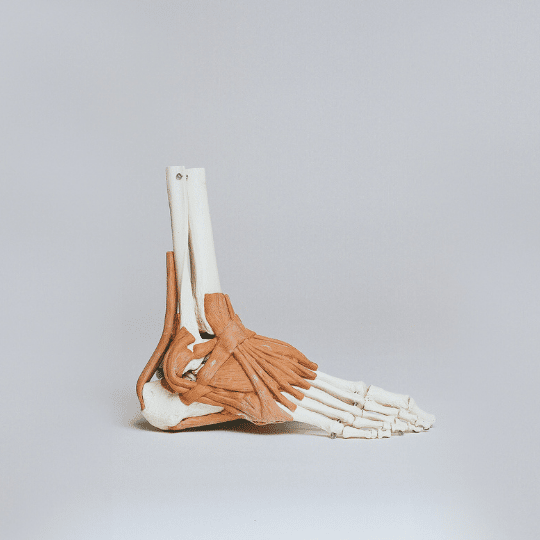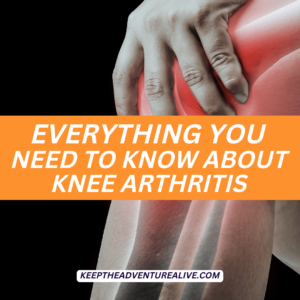An ankle with arthritis can be tricky but there are ways you can find relief! There are a few important aspects to finding relief including building ankle muscle strength as well as making sure it is moving how it should. Research points to conservative treatment as the first step in treatment including weight loss, movement, physical therapy, NSAIDs, activity modifications and the potential use of orthotics before surgical options are explored.
This article contains affiliate links that provide us with a small commission if purchase are made from the links.
If you are dealing with an ankle with arthritis, it can be hard to figure out what the first step is.
Research continues to encourage and support exercise and other conservative treatments first. Problem is, most often, people are prescribed medications and sent on their way with limited guidance.
Despite the high rates of pharmacological treatment of OA in primary care, international OA clinical guidelines emphasise self-management such as exercise and weight loss (if overweight/obese), and the use of conservative non-pharmacological interventions as first-line treatment
In this article we will explore 5 ways you can manage your ankle pain and find ways you can continue to lead an active lifestyle.
What helps an ankle with arthritis?
Have arthritis in your ankle? Is it limiting your walking ability or simply making standing hard?
You use your ankle for MANY things throughout the day. Activities like walking down stairs and walking up hills require more ankle range of motion then walking on flat ground as seen in the picture below.

If your ankle feels stiff and/or painful, bending in these directions may not be the most comfortable.
This is why it’s so important to work on getting your ankle to be more mobile. Muscle strength is also very important to help to support the ankle with arthritis as some of the cartilage (used to absorb stress before it reaches the joint) may not be functioning as efficiently.
Your ankle plays a large role in how balanced you feel too. You may notice that when you started experiencing ankle stiffness and/or pain that you may not feel as stable especially on uneven ground.
These are things that are important to address in order to get your ankle feeling better and ready to take on your next adventure.
5 simple ways to find relief: where to start
Osteoarthritis symptoms are typically caused by increase in low grade chronic inflammation which can irritate the joint and surrounding tissues. You can find out more about the causes in this video here.
It is important to build a strong, stable, mobile ankle to have success when you have an ankle with arthritis. You’re in the right place!
1. Work on mobility
As we saw in the picture above, you need specific ranges of ankle mobility to make tasks like walking especially on hills and stairs. The movement that is shown above is called dorsiflexion.
Dorsiflexion is the angle from the shin to the ankle. This is one of the most important ankle movements.
You can test to see how much dorsiflexion you have by using this video here. Please note this should not cause pain so do not force the joint in a position is doesn’t want to be in.
If you feel a pinching or sharp pain- you may be trying to push your ankle too far.
The idea for this one is make sure you keep your heel on the ground in order to work the true range of motion.
Trying to complete 5-8 reps in a comfortable range of motion can help to loosen it up, especially if you have a lot of walking ahead of you.
2. Strengthen the stabilizers
Your ankle is comprised of many small bones and supported by different muscles that connect down into your foot. You can see just how many there are in the picture below.

There are specific muscles that are known as the stabilizer muscles: your calf muscles (2), the shin muscle, and another set called the peroneals.
When walking on uneven ground, when trying to balance, and even when walking- these muscles are working hard to make sure your ankle is stable.
If you have decreased your activity level since dealing with an ankle with arthritis these muscles can become less efficient. This can then lead to more stress going to different joints.
Here are some examples on how to strengthen these muscles below.
Calf and Shin Muscles
Peroneals
Keep in mind, these movements should not increase pain significantly. If they do are are other alternatives to these movements that can help. You can find more options here.
3. improving balance
The tandem band pass balance exercise above is one example how you can both strengthen the peroneal muscles while also improving your balance. Balance and strength are connected and can help tremendously in relieving pain from ankle with arthritis.
When you are trying to balance, all of your small ankle muscles are working together to support the joint and keep it stable. Learn more about balance here.
If these muscles aren’t properly working together because of tightness, weakness, etc- it may cause you to lose your balance or feel unstable. Working on balance at least every day can be very helpful to your ankle.
I have a full 5 video series that incorporates many different balance movements that will challenge your ankle in many ways here:
When testing balance, it can also be beneficial to try on uneven or unstable surfaces such as a foam pad or a bosu ball (like in the video below) once you feel confident on hard, flat ground.
There are many other movements you can do on a bosu ball but here is an example:
4. Minimize inflammation from other sources
It has been shown that other health conditions can coincide with ankle osteoarthritis. Many chronic conditions can contribute to increased low grade inflammation in your body such as diabetes and hypertension.
Comorbidities were often managed during foot/ankle OA encounters. Nearly two thirds (65.5%) of encounters involved management of two or more problems (results not tabled). The comorbidities most frequently managed were hypertension, lipid disorders, depression, diabetes, and immunisations/vaccinations.
It is important to note that other factors besides movement can play an impact on your ankle osteoarthritis pain. Other lifestyle factors such as weight gain and smoking can actually contribute to worsening pain.
Among ankles with rAOA (radiographic ankle osteoarthritis) at baseline, currently versus never smoking was associated with over 3 times the odds of worsening FAOS (Foot and Ankle Outcome Score) symptoms. Additionally, higher BMI (body mass index) and additional symptomatic joints were associated with 30–40% higher odds of worsening FAOS symptoms
Keeping conditions like high blood pressure, diabetes, and high cholesterol under control can actually help your ankle with arthritis.
You may have heard that weight loss can contribute to decreased osteoarthritis pain as well. Excess fat tissue increases the amount of inflammation in your body. You can listen to this instagram post to learn more.
So what can you do to help reduce sources of inflammation? Find out 15 ways to reduce inflammation in this article here!
5. Be consistent
It can be frustrating if you are following certain movements or changing other lifestyle factors for a week without noticing any results.
But, especially if you have been dealing with osteoarthritis pain for a while, it may take time for you to start feeling significant relief.
Being consistent for at least 2-3 months can start to elicit great results when it comes to managing osteoarthritis pain. Too often though, many tend to give up right before the breakthrough happens!
Starting with a schedule of doing 2-3 specific movements/stretches from above and including other types of activities that do feel good is great place to start. Sidestepping can be a great way to move and strengthen other areas of your body without flaring up your ankle pain too!
Tackling Pain in your Ankle with Arthritis
These five ways listed above are a great way to get started when it comes to managing and reducing ankle arthritis pain. It’s important to not only look at strength and mobility but also other lifestyle factors as many times those are forgotten about.
If you are looking for ways to manage your osteoarthritis pain, get your ankle moving, and improve your balance, I highly recommend starting with the free 4 day arthritis friendly workout challenge!
You will get 4 days of workouts that progress in difficulty and offer a great place to start. Sign up for free down below!
Sign up for the 4 day challenge here
References:
Jaleel A, Golightly YM, Alvarez C, Renner JB, Nelson AE. Incidence and progression of ankle osteoarthritis: The johnston county osteoarthritis project. Semin Arthritis Rheum. 2021;51(1):230-235. doi:10.1016/j.semarthrit.2020.10.015
Paterson KL, Harrison C, Britt H, Hinman RS, Bennell KL. Management of foot/ankle osteoarthritis by Australian general practitioners: an analysis of national patient-encounter records. Osteoarthritis Cartilage. 2018;26(7):888-894. doi:10.1016/j.joca.2018.03.013
Disclaimer: This post is for general informational purposes only. It should not be used to self-diagnose and it is not a substitute for a medical exam, cure, treatment, diagnosis, and prescription or recommendation. It does not create a doctor-patient relationship between Dr. Kuhn and you. You should not make any change in your health regimen or diet before first consulting a physician and obtaining a medical exam, diagnosis, and recommendation. Move Well Age Well, LLC and Dr. Alyssa Kuhn, PT, DPT are not liable or responsible for any advice, course of treatment, diagnosis or any conclusions drawn, services or product you obtain through this post, video or site. Complete all exercises at your own risk.

The Arthritis Adventure Blueprint
Dr. Alyssa Kuhn’s signature program to help you go from hopeless to hopeful with osteoarthritis. You will learn the secrets to arthritis pain relief that actually work- including exercise, diet, and other ways to control inflammation! Say goodbye to short term pain relief, it’s time to make it last.




